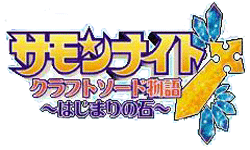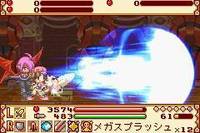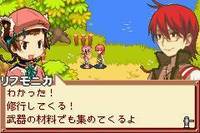|
|

|
PLATFORM
|
GBA
|
BATTLE SYSTEM
|

|
INTERACTION
|

|
ORIGINALITY
|

|
STORY
|

|
MUSIC & SOUND
|

|
VISUALS
|

|
CHALLENGE
|
Hard
|
COMPLETION TIME
|
20-40 Hours
|
|
OVERALL

|
+ Weapon crafting is enjoyable and addictive
+ Optional content is plentiful
- Challenge is inconstant and painful
- Cannot save anywhere in a portable RPG
|
Click here for scoring definitions
|
|
|
On the Game Boy Advance, the Summon Night series deviated from its tactical roots to deliver a trilogy of action RPGs. The first two were brought to the English speaking masses courtesy of Atlus as Summon Night: Swordcraft Story 1 and 2, but the third remained in Japan as Summon Night Craft Sword: Hajimari no Ishi. If Atlus had released it in English the title would no doubt have been Summon Night: Swordcraft Story 3, and that would have been a completely appropriate moniker for a game that follows in its forbears' footsteps at every turn.
The defining central component to this game is the same as its predecessors', the need for the player to craft every weapon. This is actually the greatest positive the game possesses, since weapon crafting is entertaining and simple. To craft a weapon, both a shape stone for that weapon type and an ore are required. Each ore creates a different weapon, often with unique qualities and always with varied statistics. Using the same stone to craft weapons slowly increases the capability of it, which is added to the inherent ability of whatever weapon was just created. As the player continues the craft, the ability to fuse items onto weapons in order to tinker with their innate capabilities becomes available. Creating new weapons is an engrossing activity and this aspect of the game is definitely a highlight.
The combat system these weapons are used in is interesting enough, and veterans of the Swordcraft Story series will find no surprises, making an import easy. At its core the game's combat resembles a 2D fighting game, with the player's character running around on a field similar to that in almost any fighting game and attacking enemies. The A button uses the currently equipped weapon, the B button blocks attacks, pressing Up jumps, and pressing L cycles through the three weapons that can be simultaneously equipped. New to this third installment is a bow & arrow, which joins the sword, drill, fist, spear, and axe options already established in the series. All six weapon types perform differently in combat and require different tactics from the player, which is a good method of breaking up the potential monotony.
Again like its two predecessors, this Summon Night has the player choose one of four possible Guardian Beasts at the beginning. The Guardian Beast learns magic as the game progresses, and a total of four spells can be assigned for use in combat from the plethora of options that will become available. The B button multitasks to cast spells when the player toggles using the R button to switch its function, and after a moment spent charging the incantation, the Guardian Beast will appear to administer magical aid. Unlike the earlier Swordcraft Story games, a spell will be learned to summon the Guardian Beast into combat directly, though subject to a time limit before the main character is automatically returned to the field. If the protagonist is defeated in battle the Guardian Beast will automatically jump in to continue the fight, again subject to a time limit.
 Those irritating enemies like to move around so that one of them isn't in the screen to be fried.
Those irritating enemies like to move around so that one of them isn't in the screen to be fried.
|
|
Combat remains the same mixed bag it was in the first two Swordcraft Story games, however. The protagonist will often be pitted against up to four adversaries at once, and even in boss battles there will often be two opponents. Getting surrounded is a common occurrence that will bring pain to the player. Because magic takes a moment to charge before the Guardian Beast pops in, it can be difficult to get away from enemy attacks in order to use a spell. The aforementioned different weapon tactics help to keep the battles interesting, and the enemies are a varied menagerie. The ability to fight with the Guardian Beast is also interesting, and lends even more variety to the combat.
Outside of combat, interaction is simple enough. The crafting process is intuitive, and every weapon that has been forged along with the effects of items previously incorporated into those armaments can be viewed easily. Shops are clean and simple to navigate also, though the language barrier makes them a little more difficult to decipher. Switching between weapons outside of battle to interact with the environment is also done without difficulty. Identical in almost every respect to the first and second Swordcraft Story games, and easy enough to figure out even for the uninitiated, the menus of Swordcraft Story 3 will not pose a problem.
Summon Night: Swordcraft Story 3 again features a male and female protagonist the player chooses between at the game's beginning, along with four possible Guardian Beasts to assist. The choice of character affects the dialogue somewhat but the overall plot is unchanged, and even through the language barrier it is nothing special. Richie or Rifmonica (the protagonist choices) meets a young woman named Myuno with talents that are sought by nasty people who want to unlock great power. This dovetails neatly with the protagonist's journey to discover him/herself as an incredibly gifted weapons maker. The story would not warrant much comment without its propensity toward being long-winded, another holdover from earlier entries in the series.
 Rifmonica is 13. Really, that's how old the manual says she is.
Rifmonica is 13. Really, that's how old the manual says she is.
|
|
The Swordcraft Story series has always managed to look pretty good, and this entry upholds that tradition. Every weapon has a distinctive look, and in battle the sprite animations of every participant are quite impressive, displaying the graphical prowess of the Game Boy Advance. Outside of battle the game does not look nearly so superb, but the tiny sprites do have a surprisingly diverse array of animations. The music is an improvement over both preceding games, being mostly catchy and possessed of good sound quality. Voices in battle are well done also, though the extremely limited number of vocal quips the protagonist utters when uncovering items outside of battle will irritate.
The choice of protagonist and Guardian Beast offers replay incentive, along with plentiful content that opens up once the game is finished. Rounding out the entire list of possible weapons will take much longer than completing the game, which is doable in twenty to twenty-five hours. The challenge in the game is quite variable, and many bosses are capable of defeating the protagonist in seconds if one is inattentive. The time limit that affects the Guardian Beast's means that simply because it will enter battle if the protagonist is beaten, victory is far from guaranteed. One mechanic that is a holdover from Summon Night: Swordcraft Story 2 is the absence of save points in dungeons, which increases the difficulty in the wrong way. Escaping from a dungeon to run back home for saving is usually necessary, and the only way to save in a hurry is by buying an item that performs that function. Not being able to save at any time in a portable game is incredibly infuriating.
Summon Night: Swordcraft Story 3 is the best of this series, simply because it hones the traits its predecessors developed and uses them well. The little new it brings to the table will not convince anyone who disliked the earlier games to try this one, because the incremental changes do nothing to make this series play any differently. Anyone who enjoyed the earlier entries will have a good time with this one, and if it was not for the game remaining in Japan it would make the best Swordcraft Story introduction.
Review Archives
|









